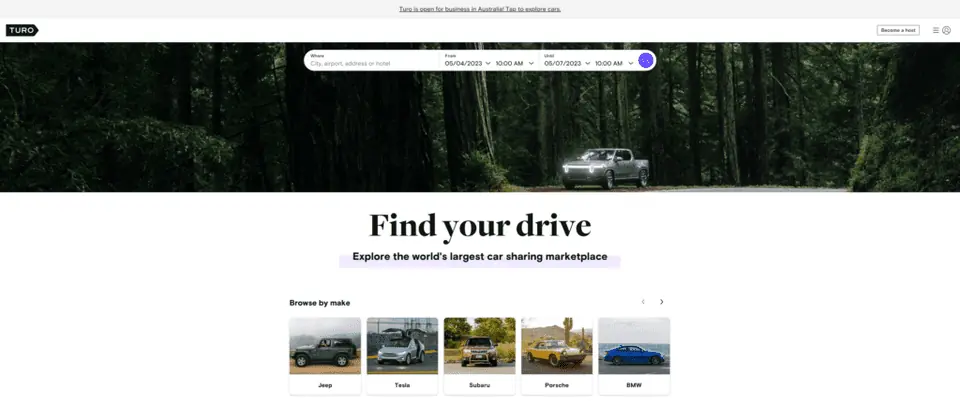Key Takeaways
- HyreCar caters to rideshare drivers, offering a streamlined process for gig economy participation.
- Turo specializes in personal driving experiences, boasting a diverse vehicle selection for varied preferences.
- HyreCar includes comprehensive insurance policies; Turo offers optional protective plans for added security.
- Choose HyreCar for gig-related rentals without long-term commitments; Turo for luxurious, personal use vehicles.
An Overview of HyreCar vs Turo
| Feature | HyreCar | Turo |
|---|---|---|
| Target Audience | Rideshare drivers | Individuals seeking personal driving experiences |
| Vehicle Selection | Primarily practical for gig economy tasks | Diverse, including luxury and high-performance vehicles |
| Insurance | Comprehensive policies included | Optional protective plans with various coverage levels |
| Use Case | Gig-related rentals without long-term commitments | Luxurious, personal use vehicles |
| Eligibility | Requires SSN, driver’s license, driving experience, clean criminal record | Requires Turo account, driver’s license, personal photo, payment method, and minimum age of 21 |
| Pros | Eliminates fake listings, allows legit drivers, flexible rental terms | Precise vehicle selection, access to luxury cars |
| Cons | Potential for run-down cars | Young-driver fee, possibly higher costs for luxury options |
| Costs | $30-40/day plus fees | $50-100/day plus additional fees |
Overview of HyreCar
HyreCar stands out as a major player in the car-sharing industry, distinguishing itself by catering specifically to rideshare drivers employed by companies like Uber, Lyft, and DoorDash.

This innovative approach not only allows car owners to earn additional income but also enables individuals without cars to participate in the burgeoning gig economy.
The process of renting is designed for ease and efficiency, ensuring that renters can quickly start their gig-related tasks, such as making deliveries for Uber Eats. This creates a mutually beneficial scenario for both car owners and renters.
Overview of Turo
Turo sets itself apart by focusing on individuals who prefer personal driving experiences, unlike HyreCar, which is more aligned with rideshare drivers.

Turo understands the unique appeal of being behind the wheel, offering a sense of control and personal freedom that services like Uber and Lyft can’t match.
The platform caters to those who value the autonomy of managing their own routes and schedules, free from the unpredictability of a rideshare driver’s availability or route choices.
Turo’s distinct advantage lies in its diverse vehicle selection, ranging from eco-friendly hybrids to high-performance sports cars, catering to various preferences and occasions.
This service is ideal for anyone desiring the liberty of self-driven journeys, with the added luxury of choosing from an array of top-tier vehicles.
Key Differences Between HyreCar and Turo
Although both companies are in the car-sharing business, HyreCar and Turo offer different experiences. They have different insurance policies and eligibility requirements, too.
So, before we get to the specifics, let’s cover the basic groundwork.
Insurance Policies
Having insurance coverage encourages you to rent cars confidently. You want to understand both companies’ policies before you choose which one to rent from.
Turo Insurance Policies
Turo doesn’t provide insurance automatically, which is probably their biggest downside. If you have insurance yourself, they can offer protective plans that you can accept or decline. These include:
| Plan | 60 plan | 75 plan | 80 plan | 85 plan | 90 plan |
| Host take | 60% of the trip price | 75% of the trip price | 80% of the trip price | 85% of the trip price | 90% of the trip price |
| Liability coverage | $750,000 | $750,000 | $750,000 | $750,000 | $750,000 |
| Exterior wear-and-tear | Not covered | Not covered | Not covered | Not covered | Not covered |
| Deductible for physical damage | $0 | $250 | $750 | $1,625 | $2,500 |
| Replacement vehicle reimbursement costs | $50 a day (up to 10 days) | $30 a day (up to 10 days) | Not covered | Not covered | Not covered |
| Loss of hosting income during repairs | Turo is responsible, or the host can have a ten-day Replacement vehicle reimbursement | Not covered | Not covered | Not covered | Not covered |
HyreCar Insurance Policies
Unlike Turo, HyreCar offers comprehensive insurance policies. You get four insurance plans, each with different perks:
| The plan | The deductible | Rental fees | Gas reimbursement |
| The basic plan | $3000 deductible | Earn 85% of rental fees | 65% gas reimbursement |
| The standard plan | $2500 deductible | Earn 80% of rental fees | 80% gas reimbursement |
| The premium plan | $1000 deductible | Earn 75% of rental fees | 85% gas reimbursement |
| The premium plus plan | $500 deductible | Earn 70% of rental fees | 100% gas reimbursement |
Eligibility Requirements for Turo and HyreCar
Both platforms have different eligibility requirements. Some are more restricting than others.
Turo’s Eligibility Requirements
To be eligible to rent a car from Turo, you need:
- A Turo account
- Driver’s license number (Valid permanent license for U.S. citizens)
- Personal photo
- Payment method
- A home Address
- To be at least 21
- Auto insurance score (for U.S. citizens)
HyreCar’s Eligibility Requirements
HyreCar has different eligibility requirements. These include:
- A valid social security number
- A driver’s license
- One year of driving experience (for people between the ages of 21-24)
- Three months of driving experience (for people 25+)
- Clean criminal record
- Passing a motor vehicle record check
Note: Your car also needs to pass the Hyrecar vehicle requirements.
Pros and Cons of HyreCar
Now that you understand the main differences between both platforms, let’s get into the pros and cons of each.
Pros of HyreCar
HyreCar is a big company for a reason. It offers various benefits to ensure you have a safe, smooth rental experience.
Eliminates Fake Listings
If you’ve ever rented a car before, you probably know that fake listings are all over the internet. Well, you don’t have to worry about that anymore.
Here’s how Hyrecar works: Once a car owner makes a listing, the company workers contact and question them to ensure it’s not fake.
Only Allows Legit Drivers
Yes, the company runs background checks for the renters, searching for criminal records, credit scores, driving records, etc. You might think that’s too inconvenient, as it makes the renting process take longer.
Think of it this way: It shows the platform is serious about offering the most legit renting experience. Besides, the background check only takes a few hours, which isn’t that long.
No Strings Attached
HyreCar understands that first-time drivers will be hesitant to use their services. That’s why it doesn’t require long-term commitment.
You can rent a vehicle for a couple of days (the minimum rental duration) to test the water. If you enjoy the service, you can extend the rental period for as long as you like, whether it’s by a day, a week, or a month.
Cons of HyreCar
HyreCar isn’t a perfect company. Like any other service, you’re bound to face a few issues.
Run-Down Cars
We’re not saying that all the cars in their platforms are run-down. Remember, HyreCar targets rideshare drivers.
These people rent cars intending to achieve long-term mileage. Chances are: The platform’s cars won’t be in premium condition.
Pros and Cons of Turo
If HyreCar is such a convenient platform, how does Turo compare?
Pros of Turo
We can dedicate an entire post to Turo’s pros, but we’ll try to make this concise.
You Know What You’re Getting
We know how hard it is to know the exact model you’re getting with car rental companies. You don’t have to worry about that with Turo. The car you clicked on is the one you’re getting.
Fancy Cars
Turo isn’t a traditional car rental company with an inventory of regular cars. It offers the most luxurious brands on the market, from Porsche and Lamborghini to Ferrari and Tesla.
Cons of Turo
Now that you know the benefits of using Turo, let’s see some of the drawbacks.
Young-Driver Fee
A young-driver fee is an additional cost that Turo charges if you’re under 25. It usually ranges between $30-50.
Here’s the problem; Some people have reported paying that fee despite being 25, so you want to look out for that.
Making the Decision: Factors to Consider
Now that we’ve covered the pros and cons of both companies, it’s time to choose a winner.
Here’s the catch: There isn’t one. Ultimately, your decision should depend on your needs and which platform caters to them more.
1. Intention
As you know by now, both companies have different target audiences. If you’re looking to secure a rental vehicle to earn extra cash doing deliveries, HyreCar is your best bet.
If you want it for personal use, Turo has got you covered.
2. Costs
Costs can’t be a decisive factor in deciding which platform is suitable for you. Both platforms have similar prices, though.
HyreCar
The average rate in Hyrecar is $30-40 a day. Unfortunately, there’s more to the total price than the daily rate of the car. You also pay 15% of the rate as a transaction fee and $18 for insurance.
Turo
Turo might be on the pricier side, which is natural, given that it offers more premium cars. The average daily rate of Turo’s cars is $50-100. You also pay a trip fee, which differs depending on your trip.
There are more fees included too, such as a cancellation fee and, in some cases, a security deposit. As such, the cost of Turo cars is on the high end, so make sure they’re worth it.
Wrapping Up
By now, you should know the differences between HyreCar and Turo. Ultimately, both platforms target different audiences and offer different experiences.
HyreCar is more effective for a longer rental duration with no fake listings. Turo is more suitable for a weekend trip with your friends and loved ones.







